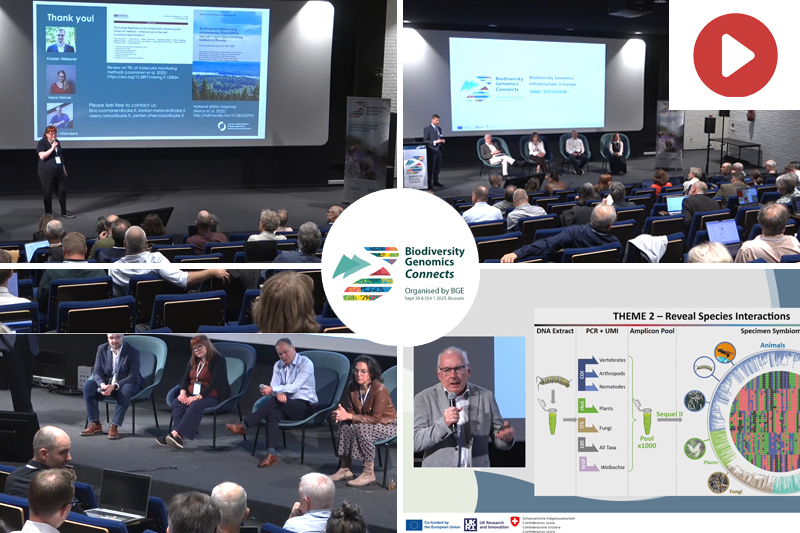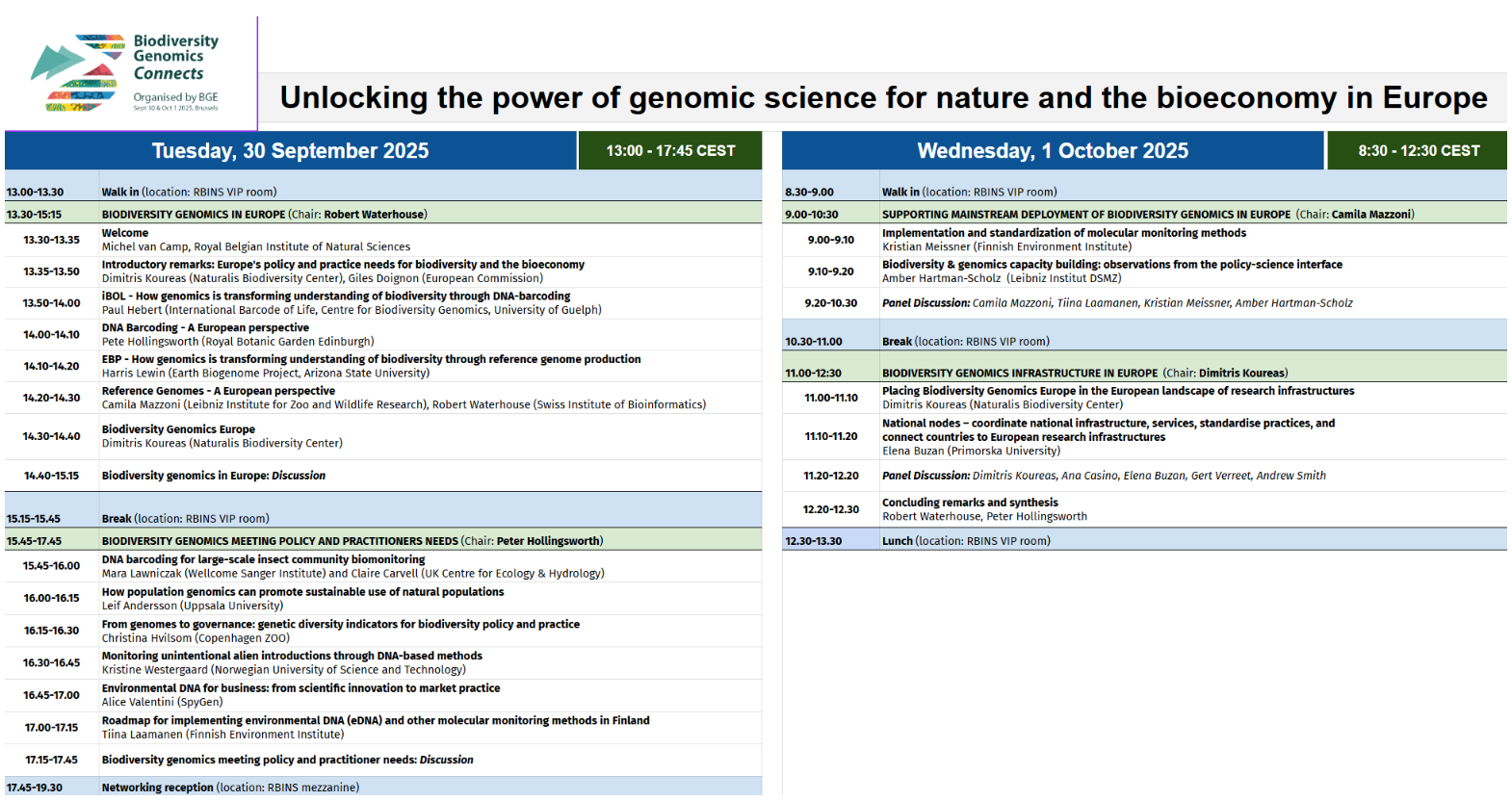Biodiversity Genomics Connects – You can now watch all sessions in full!

BIODIVERSITY GENOMICS CONNECTS (Brussels, 30 Sept – 1 Oct, 2025)
Organised by BGE, the Biodiversity Genomics Connects event provided a two-day, two-part gathering for researchers, policymakers, and stakeholders from across Europe to reflect on the state of the art and the path ahead for biodiversity genomics, both in technical and policy-related terms.
PART 1. SYMPOSIUM:
UNLOCKING THE POWER OF GENOMIC SCIENCE FOR NATURE AND THE BIOECONOMY IN EUROPE
Royal Belgian Institute for Natural Sciences, Brussels
BG Connects began with the symposium Unlocking the power of genomic science for nature and the bioeconomy in Europe, which provided the event with its scientific backbone. More than 300 participants attended the hybrid symposium, focused on the use of DNA methods and genomic science to support biomonitoring, conservation, and the utilisation of biodiversity.
Image: detailed programme of the BG Connects symposium
Session 1: Biodiversity Genomics in Europe
Already from the introductory remarks, the symposium conveyed an unequivocal message that would resonate later throughout the entire two-day event – Genomics tools are essential for accelerating species identification, monitoring ecosystems, and informing European biodiversity-related policy. Several key challenges were identified for the European case, such as coordinating efforts across countries, building comprehensive DNA reference libraries, and democratizing access to genomic technologies.
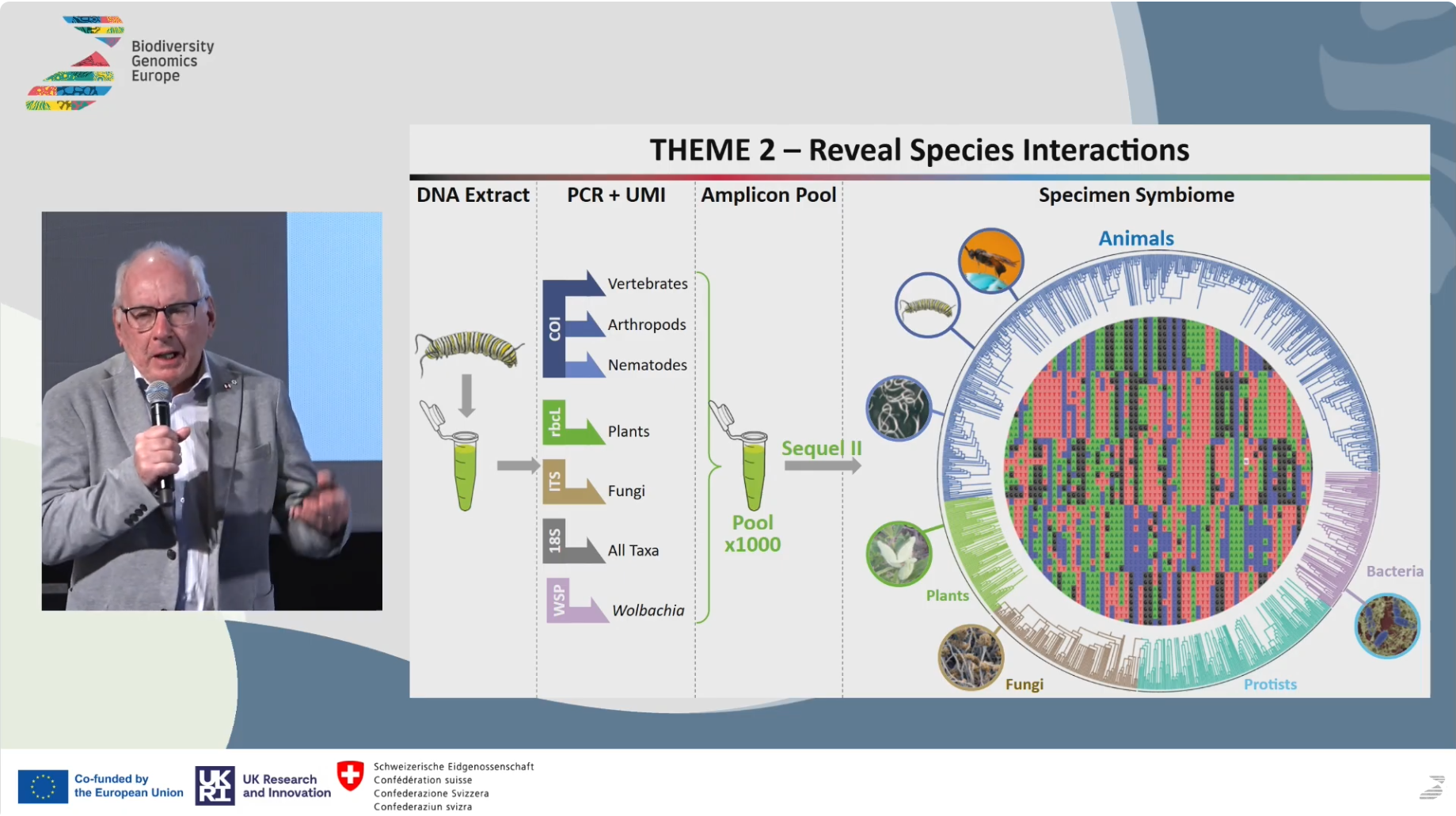
Paul Hebert (iBOL) during the symposium
The rest of session one was mostly devoted to a detailed introduction to BGE’s two communities, iBOL Europe and its parent global organisation, iBOL (International Barcode of Life), for DNA barcoding, and ERGA (European Reference Genome Atlas) and its global counterpart, EBP (Earth Biogenome Project), for reference genomes. The presentations emphasised the importance of fostering collaboration between the barcoding and reference genome communities in Europe, and presented BGE as a successful example of this.
BGE has indeed demonstrated that coordinated, transnational efforts can overcome logistical, technical, and policy challenges, creating operational pipelines for sampling, sequencing, data management, and application. By piloting joint initiatives and sharing expertise and investments, BGE is building a model for scaling genomic knowledge production while ensuring that data and infrastructure are shared efficiently.
Click below to watch the full recording of session one of the BG Connects symposium.
Session 2: Meeting policy and practitioners’ needs
The second session of the symposium began with a mosaic of case studies on the application of DNA barcoding and reference genomes to monitor populations, reduce the impact of invasive species, support sustainable fisheries, and track genetic diversity and health for long-term survival of species and ecosystems.
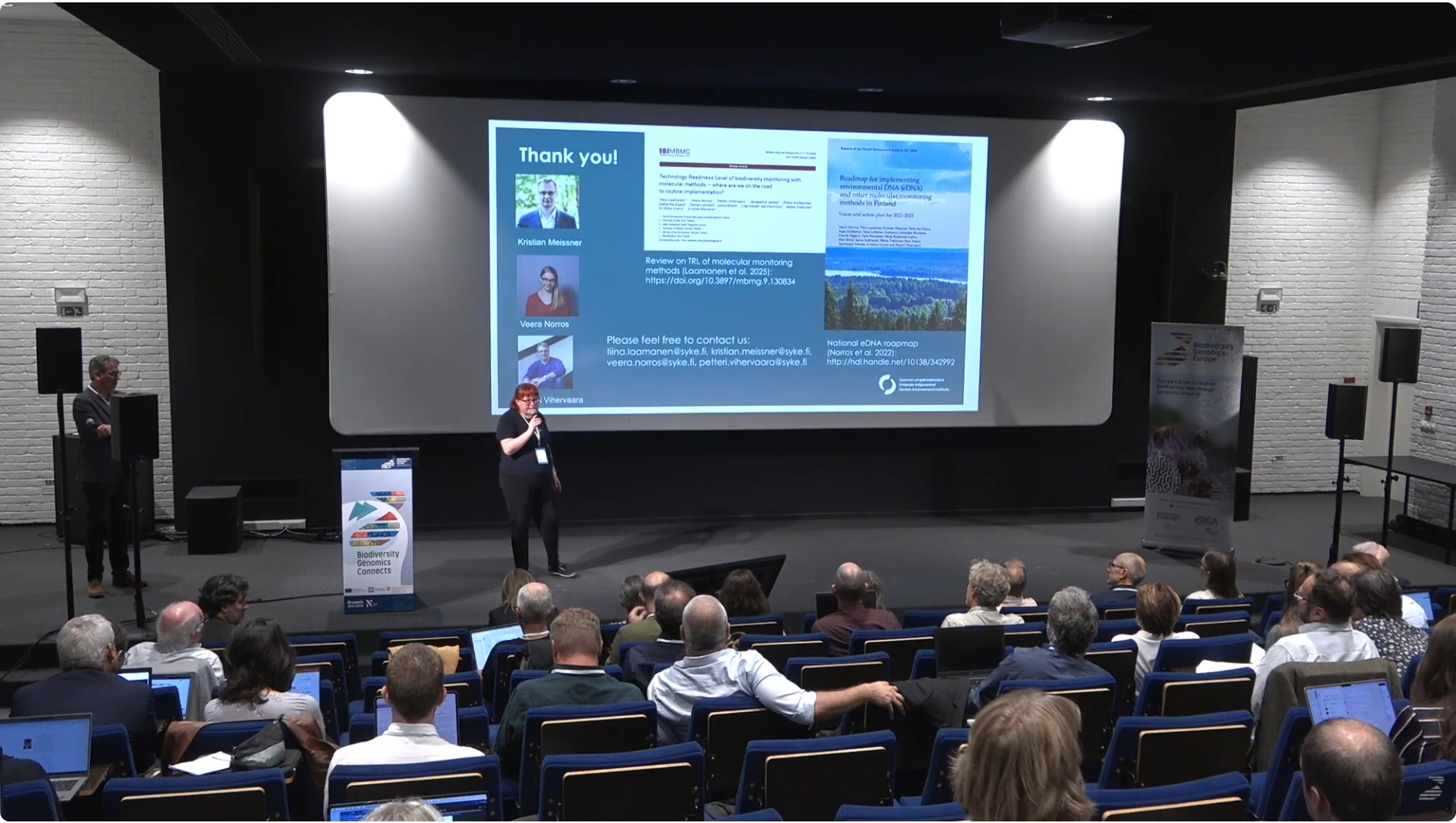
Tiina Laamanen (Finnish Environment Institute) during the symposium
The final part of the session addressed the rapid growth and commercialization of environmental DNA (eDNA) methods for effective biodiversity monitoring in water, soil, and air, as well as the need for sustained technological development, cross-domain collaboration, standardisation, and reference databases. Finland, which published its national roadmap for implementing eDNA into environmental monitoring in 2022, was presented as a successful example of implementing molecular methods for biodiversity assessment.
Click below to watch the full recording of session two of the BG Connects symposium.
Session 3: Supporting mainstream deployment of biodiversity genomics in Europe
After a brief reflection on previous discussions about how biodiversity genomics connects with policy and the needs of practitioners, the presentations and subsequent discussion of session three focused on two main topics: standardisation and capacity building.
Christian Meissner, from the Finnish Environment Institute, made the case for formal, community-based standards for molecular monitoring methods as the key link between research and policy. For her part, Amber Schultz (Leibniz Institut DSMZ) highlighted the relevance of access to resources and capacity building for many countries, particularly in the Global South, and encouraged the community of practitioners to demonstrate the direct relevance of biodiversity genomics to national priorities and the broader goals of biodiversity conservation as a way to scale biodiversity genomics globally and secure funding and support.
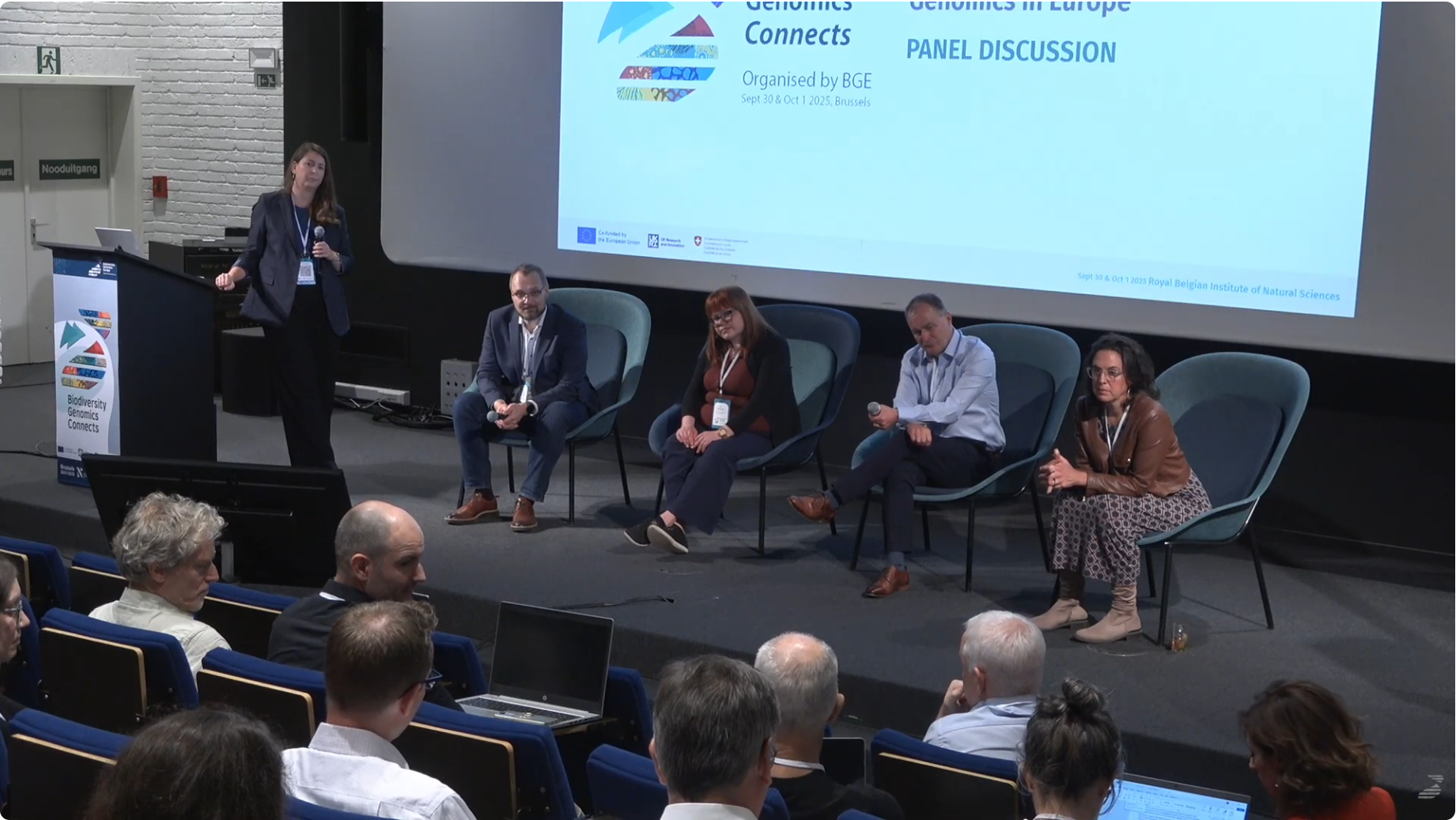
Members of the panel discussion at the end of session 3 of the symposium.
The panel discussion followed a similar line of argument, highlighting the relevance of demonstrating that molecular methods can reliably support current monitoring goals. Standardization was described as essential for ensuring data comparability and preventing inconsistent results from hindering policy confidence. However, panelists also warned that standards must be flexible enough to avoid “freezing” methods in place as technology advances.
Click below to watch the full recording of session three of the BG Connects symposium.
Session 4: A biodiversity genomics infrastructure in Europe
The final session of the BGE Connects symposium focused on moving biodiversity genomics from possibilities to practical applications at scale, emphasizing the need to bridge national and European efforts. According to Dimitris Koureas (BGE director), Europe has been successful in combining scientific innovation and coordinated funding towards targeted outcomes through its research infrastructure landscape. Such an approach has provided technical resources but also facilitated collaboration, best practices, data interoperability, and recognition for contributors.
On the other hand, as noted by Elena Bužan (Primorska University), unequal resources across countries, fragmented data standards, and regulatory barriers still hinder cross-border collaboration. National nodes are, therefore, crucial for coordinating infrastructure, harmonizing protocols, and connecting local capabilities to European networks, all of which is essential for enabling a two-way flow of knowledge between local needs and European policy and standards.
In general terms, the session highlighted the need for an integrated, interoperable, and sustainable European biodiversity genomics ecosystem to deliver scientific, policy, and potentially political impact.

Elena Buzan (Primorska University) during her presentation
It was then for the panel discussion to explore the possibilities for such an ecosystem. The debate introduced some examples, most notably DiSSCo and ELIXIR, of successful infrastructures that connect national capacities across Europe. It also explored the challenges and strategic considerations for integrating biodiversity genomics into the European infrastructure landscape. Among them, the possibility of leveraging existing research infrastructures, such as the two examples mentioned, to maximise impact while minimising duplication and costs.
Click below to watch the full recording of session four of the BG Connects symposium.
PART 2. ROUNDTABLE:
BIODIVERSITY INNOVATION: ENABLING TECHNOLOGY FOR NATURE AND GREEN GROWTH
Permanent Representation of the Netherlands to the EU
The final act of BG Connects convened a group of key policymakers, researchers, and civil society actors to explore how the most promising biodiversity genomic innovations can be scaled up as practical solutions for Europe’s environmental and economic transformation.
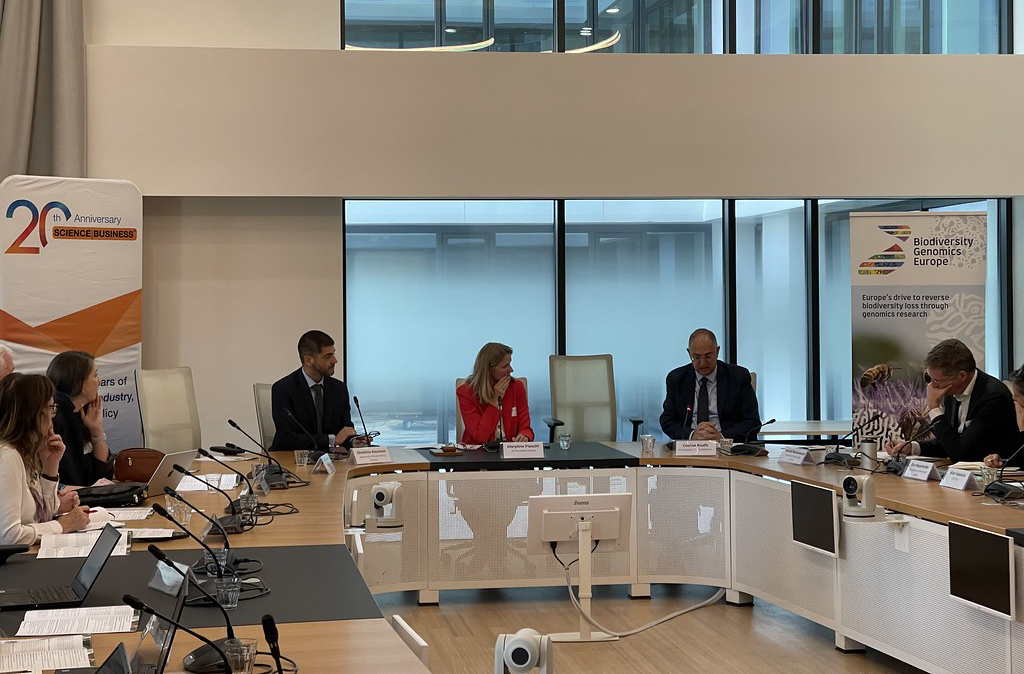
European Commissioner for Fisheries and Oceans, Costas Kadis, introduced the BG Connects roundtable
Costas Kadis, European Commissioner for Fisheries and Oceans, gave the introductory remarks, highlighting the need for a biodiversity genomics infrastructure in Europe. The idea, very much in line with BGE’s vision, and discussed during the symposium that preceded the experts’ roundtable, resonated throughout the conversation. Participants agreed on the need to explore mechanisms for a pan-European integrated approach to service delivery for biodiversity genomics. There was also ample consensus on the need to further break down data silos across Europe in favor of a larger knowledge pool, operating in sync.
The company Science Business, which supported BGE organising the roundtable, is working on a report from the event that will be made available soon.

